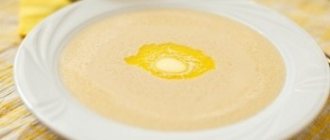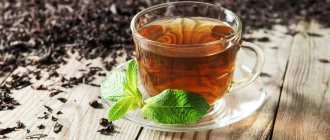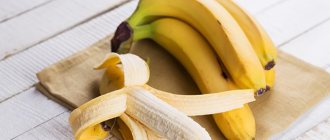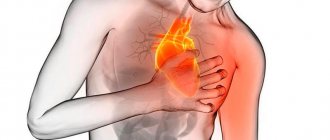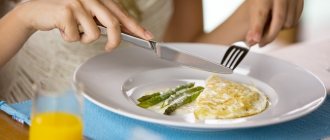( 2 ratings, average: 5.00 out of 5)
The diagnosis of atherosclerosis requires a mandatory revision of the daily menu, limitation or even complete rejection of a number of foods and drinks and the introduction of healthy foods into the diet. Such measures are necessary because the occurrence of the disease is directly related to certain unhealthy eating habits. Along with smoking, a sedentary lifestyle and stress, poor nutrition becomes a factor that aggravates the condition of a patient suffering from atherosclerosis. If adequate comprehensive measures are not taken, health becomes increasingly deteriorating and even an unfavorable outcome is possible.
General rules
Initial signs atherosclerosis can be seen even in ten-year-old children. The initial stage is characterized by the appearance of spots and stripes in the wall of the arteries that contain lipids ( lipidosis ).
Lipid spots occupy 10% of the surface of the aorta at the age of 10, and by the age of 25 they occupy 30-50% of the surface. In the coronary arteries, lipidosis develops earlier and occurs already at 10-15 years, and lipidosis of cerebral vessels - by 35-45 years. It is at this initial stage that treatment is most effective. Nutrition plays an important role in this. It turns out that prevention of atherosclerosis needs to be done from childhood.
An increase in free cholesterol and LDL fractions leads to the progression of atherosclerosis: the atherosclerotic plaque grows, the narrowing of the artery lumen progresses and the blood supply to the organ is disrupted. When the blood flow deficit is 50-70%, clinical signs develop.
With atherosclerosis of the carotid arteries, numbness or weakness in the arms or legs and speech impairment appear. If the coronary vessels are damaged, angina pectoris occurs . In such cases, anti-atherosclerotic therapy, treatment of the disease caused by atherosclerosis and nutritional therapy are prescribed.
The diet for vascular atherosclerosis is aimed at slowing the development of the disease. Its goal is to eliminate metabolic disorders, lose weight and improve blood circulation. The general principles are to reduce animal fat and carbohydrates (fast, easily digestible) in the diet.
The degree of restriction of fats and carbohydrates depends on the patient’s weight. The protein content is within the physiological norm. Salt (up to 8-10 g per day in all dishes), the amount of liquid consumed (maximum 1.2 l), cholesterol (0.3 g) and extractive substances are limited. The amount of vitamins ( C and B ), linoleic acid , dietary fiber, lipotropic substances, potassium, magnesium has been increased due to an increase in vegetable oils, vegetables, fruits, seafood and cottage cheese in the diet. Dishes are prepared without salt, and then the finished food is salted at the table.
Vegetables with coarse fiber are boiled or stewed, meat and fish are boiled. Meals are provided 5 times a day in small portions.
Foods that raise cholesterol levels
All animal products contain cholesterol and 20% of it comes from food, and the remaining 80% is produced in the body. It is low-density cholesterol that plays a role in the development of this disease, while high-density cholesterol prevents the formation of plaques. Modern man cannot completely give up animal products.
Diet for atherosclerosis of the heart vessels , as well as for atherosclerosis of other vessels, allows periodic consumption of these products, but with a low cholesterol content. Of course, you need to give up “cholesterol concentrates”: brains, offal, egg yolk, as well as dangerous trans fats (mayonnaise, margarine). A little butter is allowed.
According to research, the danger is not cholesterol in foods, but the lack of sufficient fiber in food, which comes from vegetables, fruits, and bran. The real enemies of this disease are refined carbohydrates. Therefore, with atherosclerosis of the aorta and heart vessels, sugar, flour products, potatoes and baked goods in the form of semi-finished products are limited.
Considering that aortic atherosclerosis is observed in people over 50 years of age who suffer from obesity and concomitant diabetes mellitus , limiting carbohydrates will only be beneficial.
Violation of the structure of the vascular wall of the aorta leads to the formation of an aneurysm, which enlarges and thins and can lead to rupture of this large artery.
Diet for vascular atherosclerosis. Basic Rules
Following dietary and lifestyle recommendations is not at all as difficult a task as it might seem at first glance. The patient is required to have discipline and awareness of the importance of following the instructions necessary to maintain health, improve the quality of life in general and further have a positive prognosis. On the subject: How not to eat after 6 pm Doctors' orders include:
- Refusal from meat broths, fatty, salty and smoked foods and semi-finished products and replacing them with healthy dishes (stewed, boiled and baked).
- Regular meals (small portions) – four or more times a day.
- A balanced menu with optimal content of micro- and macroelements, carbohydrates and proteins.
- Limiting table salt.
- Hot spices/condiments are prohibited.
- Including a sufficient amount of fiber-rich foods in the menu.
- Lots of fresh vegetables and fruits.
- Consumption of low-fat dairy products (in doses indicated by a nutritionist).
If you are overweight, patients are required, under the supervision of specialists, to take measures to lose weight by practicing fasting days. Homemade weight loss and dietary nutrition without consulting a specialist is prohibited! Illiterate actions cause harm to the body. On the recommendation of a doctor, it is necessary to completely avoid or significantly limit the following products:
- sugar;
- candies and various sweets;
- mayonnaise;
- store-bought sauces;
- ketchup;
- bakery products made from wheat (white) flour;
- offal;
- red meat;
- sweet carbonated drinks;
- store-bought juices/nectars;
- cocoa;
- canned fish and meat;
- dried fruits (high in sugars);
- strong coffee and tea.
Preference should be given to foods with a low hypoglycemic index.
Varieties
There are two dietary options.
The first option for non- obese : protein content - 90-100 g (half of them of animal origin), fats - 80 g (half of vegetable origin), carbohydrates - 350-400 g (50 g of sugar per day in all dishes). The calorie content of this food option is 2600-2700 kcal.
The second option is prescribed for concomitant obesity and is characterized by a reduced amount of fat (up to 70 g per day), carbohydrates (300 g) and calorie content (2200 kcal).
Authorized Products
Vegetable soups, cabbage soup, beetroot borscht, vegetarian soups with potatoes and a small amount of cereal are allowed (everything except semolina and rice).
Meat and poultry should be selected from low-fat varieties and served boiled or baked, chopped or in pieces.
The basis of the weekly diet should be fish and seafood dishes, including seaweed.
Fish and seafood
The side dish is prepared from all types of cabbage, carrots, beets, eggplants, zucchini, pumpkin, potatoes and green peas. Cucumbers, white cabbage, tomatoes, lettuce, and greens are consumed fresh.
When sitting down at the table, you need to fill half the plate with vegetable salad, 2/3 of the remaining half with porridge, and the remaining half with protein products. As for appetizers, vinaigrettes and salads seasoned with vegetable oil are allowed, daily consumption of seaweed, jellied fish and meat, soaked herring, lightly salted cheese, low-fat ham and dietary sausages are mandatory.
Bread may be made from wheat, rye, soy flour, wholemeal flour, grain flour, or with bran. Dry, unpalatable cookies. Baked products are made with the addition of wheat bran and without salt. The filling can be cottage cheese, cabbage, fish or meat.
Milk and fermented milk products are consumed with reduced fat content, low-fat cottage cheese or 5% and 9% fat content, sour cream is allowed only in dishes. Eggs are allowed up to 3 eggs per week and are prepared soft-boiled or in the form of omelettes. From buckwheat, oatmeal, millet and barley cereals, crumbly porridges, cereals and casseroles are prepared with the addition of vegetables or cottage cheese.
Fruits and berries are consumed raw, in compotes, and jellies. They are prepared semi-sweet or with xylitol. If necessary, sauces are prepared with vegetable broth, milk and tomato sauces, seasoned with sour cream. Weak tea with milk, coffee drinks, weak coffee, vegetable, berry or fruit juices are allowed.
Daily intake of rosehip decoction and wheat bran. Dietary butter and vegetable oils are used for cooking and in dishes. Enrich your diet with fresh garlic if there are no contraindications from the gastrointestinal tract. It is a good anti-sclerotic agent. Fenugreek seeds and flax seeds, ground in a coffee grinder, should be added regularly to food as they help reduce cholesterol levels.
Table of permitted products
| Proteins, g | Fats, g | Carbohydrates, g | Calories, kcal | |
Vegetables and greens | ||||
| greenery | 2,6 | 0,4 | 5,2 | 36 |
| eggplant | 1,2 | 0,1 | 4,5 | 24 |
| beans | 6,0 | 0,1 | 8,5 | 57 |
| zucchini | 0,6 | 0,3 | 4,6 | 24 |
| cabbage | 1,8 | 0,1 | 4,7 | 27 |
| broccoli | 3,0 | 0,4 | 5,2 | 28 |
| boiled cauliflower | 1,8 | 0,3 | 4,0 | 29 |
| bulb onions | 1,4 | 0,0 | 10,4 | 41 |
| carrot | 1,3 | 0,1 | 6,9 | 32 |
| cucumbers | 0,8 | 0,1 | 2,8 | 15 |
| salad pepper | 1,3 | 0,0 | 5,3 | 27 |
| salad | 1,2 | 0,3 | 1,3 | 12 |
| beet | 1,5 | 0,1 | 8,8 | 40 |
| celery | 0,9 | 0,1 | 2,1 | 12 |
| soybeans | 34,9 | 17,3 | 17,3 | 381 |
| asparagus | 1,9 | 0,1 | 3,1 | 20 |
| tomatoes | 0,6 | 0,2 | 4,2 | 20 |
| Jerusalem artichoke | 2,1 | 0,1 | 12,8 | 61 |
| pumpkin | 1,3 | 0,3 | 7,7 | 28 |
| beans | 7,8 | 0,5 | 21,5 | 123 |
| garlic | 6,5 | 0,5 | 29,9 | 143 |
| lentils | 24,0 | 1,5 | 42,7 | 284 |
Fruits | ||||
| avocado | 2,0 | 20,0 | 7,4 | 208 |
| oranges | 0,9 | 0,2 | 8,1 | 36 |
| pomegranate | 0,9 | 0,0 | 13,9 | 52 |
| grapefruit | 0,7 | 0,2 | 6,5 | 29 |
| pears | 0,4 | 0,3 | 10,9 | 42 |
| kiwi | 1,0 | 0,6 | 10,3 | 48 |
| lemons | 0,9 | 0,1 | 3,0 | 16 |
| mango | 0,5 | 0,3 | 11,5 | 67 |
| tangerines | 0,8 | 0,2 | 7,5 | 33 |
| nectarine | 0,9 | 0,2 | 11,8 | 48 |
| peaches | 0,9 | 0,1 | 11,3 | 46 |
| apples | 0,4 | 0,4 | 9,8 | 47 |
Berries | ||||
| Red currants | 0,6 | 0,2 | 7,7 | 43 |
| black currant | 1,0 | 0,4 | 7,3 | 44 |
Nuts and dried fruits | ||||
| nuts | 15,0 | 40,0 | 20,0 | 500 |
| cashew | 25,7 | 54,1 | 13,2 | 643 |
| sesame | 19,4 | 48,7 | 12,2 | 565 |
| flax seeds | 18,3 | 42,2 | 28,9 | 534 |
| fenugreek seeds | 23,0 | 6,4 | 58,3 | 323 |
| sunflower seeds | 20,7 | 52,9 | 3,4 | 578 |
Cereals and porridges | ||||
| buckwheat (kernel) | 12,6 | 3,3 | 62,1 | 313 |
| oat groats | 12,3 | 6,1 | 59,5 | 342 |
| cereals | 11,9 | 7,2 | 69,3 | 366 |
| millet cereal | 11,5 | 3,3 | 69,3 | 348 |
| barley grits | 10,4 | 1,3 | 66,3 | 324 |
Raw materials and seasonings | ||||
| honey | 0,8 | 0,0 | 81,5 | 329 |
Dairy | ||||
| skim milk | 2,0 | 0,1 | 4,8 | 31 |
| natural yogurt 2% | 4,3 | 2,0 | 6,2 | 60 |
Cheeses and cottage cheese | ||||
| cottage cheese 0.6% (low fat) | 18,0 | 0,6 | 1,8 | 88 |
| curd tofu | 8,1 | 4,2 | 0,6 | 73 |
Meat products | ||||
| beef | 18,9 | 19,4 | 0,0 | 187 |
| rabbit | 21,0 | 8,0 | 0,0 | 156 |
Sausages | ||||
| boiled diet sausage | 12,1 | 13,5 | 0,0 | 170 |
Bird | ||||
| chicken fillet | 23,1 | 1,2 | 0,0 | 110 |
| turkey | 19,2 | 0,7 | 0,0 | 84 |
Fish and seafood | ||||
| fish | 18,5 | 4,9 | 0,0 | 136 |
| squid | 21,2 | 2,8 | 2,0 | 122 |
| mussels | 9,1 | 1,5 | 0,0 | 50 |
| seaweed | 0,8 | 5,1 | 0,0 | 49 |
Oils and fats | ||||
| butter | 0,5 | 82,5 | 0,8 | 748 |
| linseed oil | 0,0 | 99,8 | 0,0 | 898 |
| olive oil | 0,0 | 99,8 | 0,0 | 898 |
| sunflower oil | 0,0 | 99,9 | 0,0 | 899 |
Non-alcoholic drinks | ||||
| mineral water | 0,0 | 0,0 | 0,0 | — |
| green tea | 0,0 | 0,0 | 0,0 | — |
| * data is per 100 g of product | ||||
Fully or partially limited products
Products made from puff pastry and butter dough, meat, fish, and mushroom broths are completely excluded. You cannot eat fatty pork, cooking fats, duck, goose, kidneys, brains, liver, sausages, canned food and all kinds of smoked meats.
Fatty fish, canned fish and caviar, salted and smoked fish are prohibited. Do not eat fatty cheese and cream, cottage cheese and sour cream. The consumption of radishes, radishes, sorrel, spinach and mushrooms is prohibited. Chocolate, ice cream, and products with cream are not allowed. As for sauces, you should not use meat, fish, mushroom, or mustard. Strong tea and coffee, cocoa are prohibited.
Limit egg yolks, rice, semolina and pasta, mayonnaise, horseradish. For obesity - grapes, sugar, honey, raisins, jam are allowed rarely and in minimal quantities.
Table of prohibited products
| Proteins, g | Fats, g | Carbohydrates, g | Calories, kcal | |
Vegetables and greens | ||||
| radish | 1,2 | 0,1 | 3,4 | 19 |
| white radish | 1,4 | 0,0 | 4,1 | 21 |
| red radish | 1,2 | 0,1 | 3,4 | 20 |
| black radish | 1,9 | 0,2 | 6,7 | 35 |
| spinach | 2,9 | 0,3 | 2,0 | 22 |
| sorrel | 1,5 | 0,3 | 2,9 | 19 |
Fruits | ||||
| bananas | 1,5 | 0,2 | 21,8 | 95 |
Berries | ||||
| grape | 0,6 | 0,2 | 16,8 | 65 |
Mushrooms | ||||
| mushrooms | 3,5 | 2,0 | 2,5 | 30 |
Nuts and dried fruits | ||||
| raisin | 2,9 | 0,6 | 66,0 | 264 |
Cereals and porridges | ||||
| semolina | 10,3 | 1,0 | 73,3 | 328 |
| rice | 6,7 | 0,7 | 78,9 | 344 |
Flour and pasta | ||||
| pasta | 10,4 | 1,1 | 69,7 | 337 |
Confectionery | ||||
| jam | 0,3 | 0,2 | 63,0 | 263 |
| jam | 0,3 | 0,1 | 56,0 | 238 |
| candies | 4,3 | 19,8 | 67,5 | 453 |
| pastry cream | 0,2 | 26,0 | 16,5 | 300 |
| cookie | 7,5 | 11,8 | 74,9 | 417 |
Ice cream | ||||
| ice cream | 3,7 | 6,9 | 22,1 | 189 |
Cakes | ||||
| cake | 4,4 | 23,4 | 45,2 | 407 |
Chocolate | ||||
| chocolate | 5,4 | 35,3 | 56,5 | 544 |
Raw materials and seasonings | ||||
| mustard | 5,7 | 6,4 | 22,0 | 162 |
| mayonnaise | 2,4 | 67,0 | 3,9 | 627 |
Dairy | ||||
| milk 3.6% | 2,8 | 3,6 | 4,7 | 62 |
| milk 4.5% | 3,1 | 4,5 | 4,7 | 72 |
| cream | 2,8 | 20,0 | 3,7 | 205 |
| sour cream 25% (classic) | 2,6 | 25,0 | 2,5 | 248 |
Cheeses and cottage cheese | ||||
| cheese | 24,1 | 29,5 | 0,3 | 363 |
| cottage cheese 11% | 16,0 | 11,0 | 1,0 | 170 |
| cottage cheese 18% (fat) | 14,0 | 18,0 | 2,8 | 232 |
Meat products | ||||
| pork | 16,0 | 21,6 | 0,0 | 259 |
| pork liver | 18,8 | 3,6 | 0,0 | 108 |
| pork kidneys | 13,0 | 3,1 | 0,0 | 80 |
| pork fat | 1,4 | 92,8 | 0,0 | 841 |
| salo | 2,4 | 89,0 | 0,0 | 797 |
| beef liver | 17,4 | 3,1 | 0,0 | 98 |
| beef kidneys | 12,5 | 1,8 | 0,0 | 66 |
| beef brains | 9,5 | 9,5 | 0,0 | 124 |
Sausages | ||||
| smoked sausage | 16,2 | 44,6 | 0,0 | 466 |
| smoked sausage | 9,9 | 63,2 | 0,3 | 608 |
| sausages | 10,1 | 31,6 | 1,9 | 332 |
| sausages | 12,3 | 25,3 | 0,0 | 277 |
Bird | ||||
| smoked chicken | 27,5 | 8,2 | 0,0 | 184 |
| duck | 16,5 | 61,2 | 0,0 | 346 |
| smoked duck | 19,0 | 28,4 | 0,0 | 337 |
| goose | 16,1 | 33,3 | 0,0 | 364 |
Fish and seafood | ||||
| smoked fish | 26,8 | 9,9 | 0,0 | 196 |
| salted fish | 19,2 | 2,0 | 0,0 | 190 |
| Red caviar | 32,0 | 15,0 | 0,0 | 263 |
| black caviar | 28,0 | 9,7 | 0,0 | 203 |
| canned fish | 17,5 | 2,0 | 0,0 | 88 |
| cod (liver in oil) | 4,2 | 65,7 | 1,2 | 613 |
Oils and fats | ||||
| animal fat | 0,0 | 99,7 | 0,0 | 897 |
| cooking fat | 0,0 | 99,7 | 0,0 | 897 |
Non-alcoholic drinks | ||||
| instant coffee dry | 15,0 | 3,5 | 0,0 | 94 |
| black tea | 20,0 | 5,1 | 6,9 | 152 |
| * data is per 100 g of product | ||||
Menu (Power Mode)
5-6 meals a day are organized. The menu for several days may look like this:
The first day
| Breakfast |
|
| Lunch |
|
| Dinner |
|
| Afternoon snack |
|
| Dinner |
|
| For the night |
|
Second day
| Breakfast |
|
| Lunch |
|
| Dinner |
|
| Afternoon snack |
|
| Dinner |
|
| For the night |
|
Day three
| Breakfast |
|
| Lunch |
|
| Dinner |
|
| Afternoon snack |
|
| Dinner |
|
| For the night |
|
About drinks
In order not to create additional stress on the blood vessels of the brain and heart, you should stop drinking coffee. Sweet soda should be completely excluded from the diet. Healthy drinks include:
- compote of fresh or frozen berries;
- fruit compote or jelly (no added sugar);
- green tea with mint;
- fresh vegetable;
- decoction of rosehip, burdock and dandelion roots;
- ginger-citrus drink.
Advice! To prepare a ginger-citrus drink, you need to cut 1 orange and 1 lemon, brew with boiling water, leave for a quarter of an hour, add grated ginger root. You can drink at any time of the day. The drink has a powerful antioxidant effect, helps lower cholesterol, strengthens the immune system, and promotes weight loss.
Advantages and disadvantages
| pros | Minuses |
|
|
conclusions
Proper nutrition is an important aspect of treating atherosclerosis. Its principles are simple and painfully familiar to everyone: a minimum of fatty and sweet foods, more natural products. Still, the origins of the human race are lost somewhere in the lap of nature, and not behind the door of the nearest fast food restaurant.
Diet for atherosclerosis – both treatment and prevention. It is in the patient’s interests to make it primary (aimed at preventing the onset of symptoms of the disease) by studying healthy recipes.
Comments from nutritionists
The question is often asked: will fasting help cope with atherosclerosis? Indeed, therapeutic fasting can be used in the treatment of the initial stages of the disease. However, there are contraindications: arrhythmias , severe atherosclerosis , thyrotoxicosis , a tendency to thrombosis , liver and kidney pathology and others. In the absence of contraindications, short-term unloading can be carried out. However, the effectiveness of therapeutic fasting in the treatment of this disease is currently being questioned, and it has not been scientifically confirmed. Some studies (on birds) have confirmed the opposite - metabolic disorders during fasting, on the contrary, lead to hypercholesterolemia .
The rule of life for such patients should be a balanced diet, and this dietary table meets all the requirements and takes into account all the main aspects of nutrition that lead to the progression of the disease. It is very important to maintain high-density cholesterol levels. This is possible due to the daily intake of omega-3 PUFAs from food, since they are not formed in the body. Their daily requirement is 2 g. As a guide, we present the content of 100 g of products: flax seed is in the lead - 22.8 g, walnuts are in second place - 6.8 g, mackerel - 2.5 g, herring - 1.5-3, 1 g, tuna - up to 1.6 g, soy - 1.6 g, salmon - 1.4 g.
Nuts for atherosclerosis
Next, you need to consume up to 500 g of fruits and vegetables (potatoes are not taken into account). The dietary fiber of these products absorbs cholesterol; it is not absorbed into the blood and is excreted in feces. The daily requirement for dietary fiber is 25-30 g. A very large amount of it (2.5 g per 100 g of product) is found in wheat bran, beans, whole oatmeal, nuts, dates, cranberries, gooseberries, raspberries, figs, prunes, raisins and dried apricots. Slightly less (1-2 g) in cereals: buckwheat, barley, pearl barley, oat flakes, peas, carrots, cabbage, sweet peppers, eggplants, pumpkin, quince, oranges, fresh mushrooms.
In this disease, the role of antioxidants - vitamins A , E , C and selenium . Sources of vitamin A are sea fish, all citrus fruits, chicken egg yolk, carrots, tomatoes, apricots, pumpkin, spinach.
Vitamin C is found in all vegetables and fruits, but the greatest amount is in rose hips, black currants, sea buckthorn, green peas, red peppers, Brussels sprouts and cauliflower.
Vitamin E is present in all vegetable oils, cereals, legumes, sunflower seeds, almonds, and peanuts. We get selenium from tuna, sardines, beef, and milk.
While actively pursuing your health, avoid foods that contain hidden animal fats. We are talking about sausages, sausages, ham, rolls, pates, cheeses, curd mass. Choose lean meats and additionally eliminate visible fat. When preparing dishes, use a minimum of fat - this will be possible if you use a double boiler, oven and grill.
Eat less or completely eliminate “fast”, simple carbohydrates (sugar, cakes, sweet pastries, sweets, preserves, jams). The fact is that they stimulate the body's production of insulin , which is involved in converting excess sugars into fat and also stimulates appetite. You should also consider limiting salt in your diet. It makes it difficult to break down fats, and under its influence the inner wall of blood vessels becomes loose and susceptible to cholesterol deposition.
Now, knowing the basic directions of proper nutrition, it will not be difficult to create a daily diet. The diet for atherosclerosis of the vessels of the lower extremities is no different from the general diet for this disease. In this case, a lipid-lowering diet is also prescribed - Table No. 10C or its variants (see above).
With obliterating atherosclerosis , a violation of the blood supply to the lower extremities comes to the fore, which is manifested by chilliness and numbness of the feet, cramps of the calf muscles, fatigue of the legs and intermittent claudication. In severe cases - trophic foot ulcers and gangrene . Therefore, treatment is prescribed in parallel, including a group of vascular drugs ( Trental , Vazaprostan , Ilomedin ), thrombolytics and, of course, statins - lipid-lowering drugs. The patient needs to change their lifestyle (quitting smoking and drinking alcohol), control weight and increase (if possible) physical activity.
Results
Atherosclerosis is a dangerous disease of the body’s vascular system, characterized by the deposition of “bad” cholesterol on the intima (inner layer of blood vessels). At the same time, the level of “good” cholesterol is significantly reduced.
The compaction and proliferation of cholesterol plaques leads to blockage of the lumen of the arteries, causing coronary heart disease, cerebrovascular accident with the risk of stroke, and gangrenous lesions of the lower extremities. A proper diet helps lower cholesterol levels and maintain their stability.
A diet developed on the basis of the “Table 10” diet should contain a maximum of fresh vegetables, berries and fruits, cereals and protein dishes, and healthy drinks. Therapy of atherosclerosis is a long process. It is important to strictly follow nutritional rules not only during treatment, but also for prevention (after cholesterol levels decrease).
Reviews and results
This diet is designed to last for a long time, as it is balanced and contains a variety of foods. Some restriction in carbohydrates and fats does not adversely affect health, but on the contrary allows you to lose weight, normalize cholesterol and feel good. All these points are noted in the reviews of patients.
- “...I improved my health and lost weight. I liked this healthy diet. True, I was also prescribed pills to lower cholesterol”;
- “... I’m happy with the results: cholesterol has decreased, sugar has normalized, and I’ve even lost weight. Beauty!";
- “...Cholesterol was not very high, so I managed only with therapeutic nutrition. I continue to eat like this”;
- “... My result is minus 5 kg, my general condition has improved significantly and my tests have become normal”;
- “... Helped me lose weight and improve my condition, but I think that the tests became normal thanks to the pills. I won’t push myself further and will eat right.”
- “... This is not even a diet, but proper nutrition. I see only benefits in low-fat dishes without frying or batter. I eat constantly, even though no one prescribed it for me. Cholesterol is normal."
